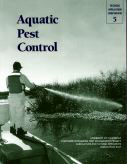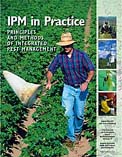|
|
Annual Reports
2000—New UC IPM Publications
CONTENTS:
Aquatic Pest Control
IPM in Practice: Principles
and Methods of Integrated Pest Management
Integrated Pest Management for Floriculture and
Nurseries
For ordering information, access the UC IPM "how-to-order"
page.
Aquatic
Pest Control
 Released in early 2001, Aquatic
Pest Control (Vol. 5 in UC IPM's Pesticide Application Compendium
series) is a must-have resource for anyone involved in pest control in
aquatic settings. This publication is the recommended study guide for
people preparing for the Department of Pesticide Regulation's Qualified
Applicator examinations in the Aquatic Pest Control category, to be used
with The Safe
and Effective Use of Pesticides, 2nd ed. (Vol. I in this series).
This 168-page manual includes an extensive chapter on identifying aquatic
weeds commonly found in California, and sections on types and characteristics
of aquatic weeds; chemical, mechanical, cultural, and biological control
of aquatic weeds; vertebrate and invertebrate pests in aquatic settings;
safe handling of pesticides; and selection and calibration of aquatic
herbicide application equipment. The book has more than 110 photographs
and 57 drawings, including many that are useful in identifying aquatic
weeds. Released in early 2001, Aquatic
Pest Control (Vol. 5 in UC IPM's Pesticide Application Compendium
series) is a must-have resource for anyone involved in pest control in
aquatic settings. This publication is the recommended study guide for
people preparing for the Department of Pesticide Regulation's Qualified
Applicator examinations in the Aquatic Pest Control category, to be used
with The Safe
and Effective Use of Pesticides, 2nd ed. (Vol. I in this series).
This 168-page manual includes an extensive chapter on identifying aquatic
weeds commonly found in California, and sections on types and characteristics
of aquatic weeds; chemical, mechanical, cultural, and biological control
of aquatic weeds; vertebrate and invertebrate pests in aquatic settings;
safe handling of pesticides; and selection and calibration of aquatic
herbicide application equipment. The book has more than 110 photographs
and 57 drawings, including many that are useful in identifying aquatic
weeds.
IPM
in Practice: Principles and Methods of Integrated Pest Management
 In
spring 2001 the IPM Project will release the first practical field guide
for setting up and carrying out an IPM program in virtually any type of
crop or landscape. Developed as a study guide for individuals preparing
to take the California Pest Control Adviser licensing exam, IPM in
Practice is likely to become a textbook for IPM courses across the
country. In
spring 2001 the IPM Project will release the first practical field guide
for setting up and carrying out an IPM program in virtually any type of
crop or landscape. Developed as a study guide for individuals preparing
to take the California Pest Control Adviser licensing exam, IPM in
Practice is likely to become a textbook for IPM courses across the
country.
Authors Mary Louise Flint and Patricia Gouveia worked with over 50 University
of California and California State University researchers, Cooperative
Extension specialists, farm advisors, and PCAs to identify the essential
information PCAs need to know when they start their jobs. This information,
posted on the California Department of Pesticide Regulation Web site as
IPM Knowledge
Expectations, guided the writing of the book and will provide a structure
for new licensing exams to be introduced in 2003. Chapters cover ecological
principles, the IPM concept, basic pest identification and biology, general
management techniques, monitoring and decision-making guidelines, how
to set up monitoring programs and field trials, pesticide hazards and
concerns, and methods of communicating with clients. More than 300 photographs,
line drawings, and sidebars illustrate practical field techniques.
Integrated
Pest Management for Floriculture and Nurseries
 California's
$2.5 billion-a-year flower, foliage, and nursery crops industry will benefit
from the fourteenth and largest of the IPM manuals. Available in spring
2001, this publication will help users create better crops, more profit,
and a healthier environment. Integrated Pest Management for Floriculture
and Nurseries was written for growers, farm advisors, IPM scouts,
pesticide applicators, pest control advisers, and students. It provides
information on pests affecting bulbs, cut flowers, potted flowering plants,
foliage plants, bedding plants, and ornamental trees and shrubs grown
in the field, greenhouse, and nursery. California's
$2.5 billion-a-year flower, foliage, and nursery crops industry will benefit
from the fourteenth and largest of the IPM manuals. Available in spring
2001, this publication will help users create better crops, more profit,
and a healthier environment. Integrated Pest Management for Floriculture
and Nurseries was written for growers, farm advisors, IPM scouts,
pesticide applicators, pest control advisers, and students. It provides
information on pests affecting bulbs, cut flowers, potted flowering plants,
foliage plants, bedding plants, and ornamental trees and shrubs grown
in the field, greenhouse, and nursery.
This IPM manual contains over 300 high-quality color photographs
by Jack Kelly Clark and 164 line art illustrations and tables. Individual
chapters detail the prevention, diagnosis, and management of abiotic disorders,
pathogenic diseases, insects and mites, nematodes, and weeds. Detailed
crop tables list over 120 flower and ornamental nursery crop species or
genera and the specific pests attacking each of them.
Compiled by Steve H. Dreistadt, over 70 experts contributed to or reviewed
the book, mostly University of California researchers and Cooperative
Extension advisors and specialists.
Top of page
|


